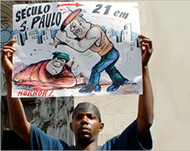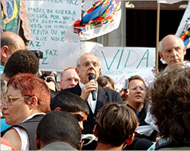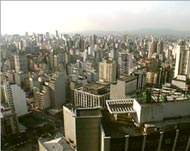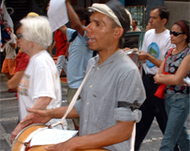Where death lurks around the corner
Declaring they have lost confidence in the military police, hundreds of people are sleeping out in the streets of Sao Paulo this week in an act of solidarity with the city’s homeless.

What galvanised them into action were two recent incidents described by President Luiz Inacio Lula da Silva as “barbarous crimes which smell of prejudice”.
A group of perhaps 10 men, armed with a single wooden club, went on a killing spree of homeless people in the centre of Sao Paulo on 19 August. Such was the ferocity of bludgeoning that three died with just one blow to the head.
Weaving from one end of the historical centre to another, they roamed for three hours carrying out five separate attacks, unchecked in a well-policed area in the biggest city in Brazil.
 |
|
Out of the 15 people targeted in |
In front of the stock exchange, the famous cathedral and public squares, they carried out the worst violence ever seen in Sao Paulo against “people of the street”, all beaten about the head and face.
And just as the city was reeling in shock at the news, they did it again three days later (on 22 August), in the same area, again apparently unseen.
In all, fifteen people were attacked and six died. The final toll could be much higher: one unidentified man is in a coma with multiple fractures to the head and four more still have life-threatening injuries.
In the dark
Benedito Souza, Cosme Rodrigues Machado Antonio Odilon dos Santos and Ivanildo Amaro da Silva, known as Pantera, have been named as the dead victims. Two others remain unidentified.
“I’ve lived in the streets for 15 years,” said Anderson. “What is happening here is a massacre of people who live in the streets. We don’t know who is doing it. “
He said, “I knew Pantera, who was murdered brutally. We know each other in the community here and she used to take a shower in the same place as me.”
 |
|
The killers chose paulistanos of |
Pantera was a transvestite, but the victims are all of mixed genders, ages and creeds. The theories gaining force is that it was either a death squad paid for by local businesses to rid the streets of the homeless in the commercial district or an extremist group of “intolerance”.
Police have released a photo fit of two men, one black and one white, believed to have been behaving suspiciously in the area on the first night of the attacks.
Many believe the police could have been involved, if only because they turned a blind eye to the incidents.
The attacks are being remarked upon in the same breath as the Candelaria massacre of street kids by off-duty policemen in Rio de Janeiro in 1993.
“Here in the centre is very well policed, but not for us, the people of the street. When we call for help from the police, they ignore us or they beat us,” said Anderson.
“They aren’t here for our safety. There doesn’t exist the word ‘safety’ for us. Safety’ is God, it’s only God who protects us at night against the killings, the violence, the burnings.”
 |
|
Justice Minister Bastos called it |
He continued: “The police are saying that we, the people in the streets, are fighting between us, but this is a lie. There’s no way we would kill our own brothers.
“We fight, yes, over food, but there is no way one would murder one another. We think that the businessmen are paying groups to eliminate us.”
Special mass
One of the survivors of the attacks, Jose Manual da Cruz, 49, has said he remembers around ten men, but that he did not see any of the markings of extremist groups, such as tattoos and shaved heads.
On 22 August after the second night of attacks, 1000 people assembled in front of the famous Roman Catholic cathedral in the city centre for a special mass.
They then marched through the streets, stopping at the points where each killing had taken place to sing and pray and observe a minute’s silence.
 |
|
Up to 10,000 people sleep rough |
A hastily constructed cross of wood and cardboard was placed momentarily at each site.
“Fear grows every day. We are very afraid. There are hostels, more than 40 of them where they put street people. Today the mayor is here trying to get us to go, but we are afraid of the hostels because of the repression there we have already suffered, so we prefer to be on the street. But the fear remains constant because you never know whether you are going to sleep here in the centre, ” says Anderson.
Living on edge
Luiz Barbosa da Silva’s son, Anderson Viera Rodrigues, 28, has been missing for 10 months.
Each time there is attack on the homeless, he comes to see if it was his son who he believes may be one of the 10,000 sleeping rough in the streets in the centre of the city of Sao Paulo.
Standing above a pool of blood, fresh from an attack just hours old, Luiz said he had no idea who was carrying out the killings.
 |
|
Homeless paulistanos’ message: |
“I think because of unemployment and the fact that the country is going through a difficult time, people are on the streets. They don’t have a perspective of living better, they don’t have a place to live, and they end up in any old corner of the street at night where they run the risk of being threatened,” he said.
In a separate incident in the same week another homeless man lost two toes when his foot was blown up by what police believe was a crude homemade bomb.
A month and a half ago six homeless people had to be taken to hospital after being given alcohol mixed with rat poison.
A joint statement signed by 21 non-governmental and religious groups who work with homeless people called for a thorough investigation.
“History repeats itself. First we had the massacre of street children at Candelaria, then the Patax Indians set fire to when they were sleeping in the road and now this – people of the streets beaten, some until they died. Have we lost the feeling of life? Isn’t living on the streets already dehumanising enough?” the statement said.
‘Abominable crime’
The Brazil Government’s Secretariat for Human Rights has pledged to follow the investigation into the case.
 |
|
Anderson says the homeless can |
“It is clear that this is being done by organised groups. We have to come up with alternatives and provide protection for these people,” declared its head, Pedro Montenegro.
Brazil’s Justice Minister, Marcos Thomasz Bastos, speaking from the steps of the Roman Catholic cathedral said: “This is a moment of crisis, a moment when we all have to be together.
“We have to find the perpetrators of this abominable crime. This is a moment of pain for the city. Justice will be done in this case.”
Bastos added, “This case is sadder, more tragic, more suffering, because of the vulnerable people who have been attacked. Let’s bring justice against these bandits.”
While words are fine, ultimately the people of Sao Paulo will judge the government by its actions.